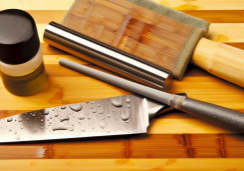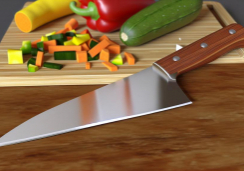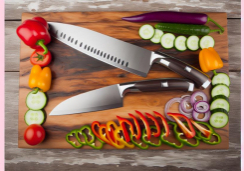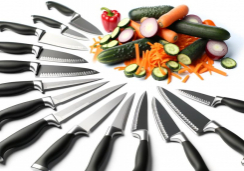5 Best Tips for High-Carbon Steel Knife Care
Imagine you've just invested in a high-quality high-carbon steel knife, admired for its superior sharpness and edge retention. You're aware that this isn't just any knife; it demands respect and meticulous care to maintain its exceptional performance.
As you hold it in your hand, you realize that the longevity of your knife hinges on the knowledge of proper maintenance. In the following sections, we'll discuss the five cardinal rules you need to adhere to, including:
- The prevention of rust and corrosion
- The nuances of proper cleaning
- The art of drying and storing to avert damage
- The critical routine of honing and sharpening
- The practices you should certainly avoid to preserve your knife's integrity.
And while you may be familiar with some basic care instructions, we're here to guide you through the subtleties that differentiate a well-maintained blade from one that dulls and deteriorates prematurely.
Preventing Rust and Corrosion
To prevent rust and corrosion, always dry your knife thoroughly after washing it. High-carbon steel, while known for its durability and sharpness, is particularly prone to rust if not properly maintained. It's crucial that you don't let your knife sit in water or stay damp for long periods.
After each use, wash your knife by hand with a mild detergent and warm water. Avoid the dishwasher, as the harsh chemicals and high temperatures can damage the blade and handle materials. Instead, immediately rinse and carefully wipe the blade with a clean, soft towel. Make sure you get into all the nooks and crannies where moisture can hide.
Once dry, apply a thin layer of food-safe mineral oil to the blade. This creates a barrier that repels water and prevents oxidation. Don't overlook this step, even if your knife hasn't been used much, as ambient humidity can also lead to rust.
Store your knife in a dry place, ideally in a knife block or on a magnetic strip. Sheaths can retain moisture, so if you use one, ensure it's well-ventilated or periodically air out the knife.
Proper Cleaning Techniques
Ensuring your knife remains in pristine condition requires mastering the art of proper cleaning, a task that's both simple and essential for any blade enthusiast. High-carbon steel knives, renowned for their superior edge retention and sharpness, demand a specific approach to upkeep.
To effectively clean your high-carbon steel knife without causing damage, follow these steps:
- Wash by Hand: Always clean your knife with warm soapy water and a soft sponge or cloth. Dishwashers can be too harsh and may cause your knife to bump against other items, leading to unnecessary wear or damage.
- Dry Immediately: After washing, don't leave your knife to air dry. Instead, use a clean towel to dry it thoroughly to prevent any water spots or rust formation.
- Avoid Abrasives: Steer clear of steel wool or scouring pads, which can scratch the knife's surface. If you encounter stubborn residue, soak the blade briefly before attempting to wipe it clean again.
- Oil the Blade: Apply a light coat of food-safe mineral oil to the blade after every few washes. This creates a barrier against moisture and helps to maintain the knife's integrity.
Effective Drying and Storage
After thoroughly washing your knife, it's crucial to dry it immediately and store it properly to prevent rust and maintain its sharpness. Don't let it air dry as this increases the risk of rusting. Instead, use a clean, absorbent towel to wipe down the blade and handle. Ensure you reach the crevices where moisture may hide. If you have a hairdryer, a quick blast can help evaporate any lingering dampness, but be cautious not to overheat the metal.
For storage, avoid tossing your high-carbon steel knife into a crowded drawer. Contact with other utensils can damage the edge and lead to corrosion. Ideally, store your knife in a block or on a magnetic strip away from moisture and direct sunlight. If those aren't options, use a blade guard or sheath, but make sure it's made of breathable material to prevent moisture accumulation. Remember, a dry environment is key.
Lastly, consider oiling the blade lightly with a food-safe mineral oil if you'll be storing it for an extended period. This creates a protective barrier against moisture and further ensures the longevity of your knife's sharpness and overall condition.
Regular Honing and Sharpening
Keep your knife's edge in prime condition through regular honing and timely sharpening, both of which are essential to the longevity and performance of your cutting tools.
Honing with a steel rod straightens the edge of your knife, correcting the microscopic bends that occur with regular use. It doesn't remove material but realigns the edge for better cutting efficiency. You should hone your high-carbon steel knife before each use to maintain its sharpness.
Sharpening, on the other hand, actually removes metal from the blade to create a new edge. This process is needed less frequently – only when honing is no longer effective at restoring the knife's sharp edge.
For high-carbon steel knives, here's a concise guide to keeping your edge:
- Hone Often: Before each use, run the blade along a honing rod to maintain sharpness.
- Sharpen Wisely: Sharpen your knife when honing no longer achieves the desired sharpness.
- Use Correct Angles: Maintain the correct angle for your knife's edge – usually between 15 to 20 degrees.
- Seek Professional Help: If you're uncomfortable sharpening yourself, have your knives professionally sharpened to avoid damaging the blade.
Adhering to these practices ensures your high-carbon steel knives will cut with precision and ease for years to come.
Avoiding Damaging Practices
To maintain your knife's integrity, steer clear of practices that can cause damage, such as using it as a can opener or screwdriver. High-carbon steel knives are crafted for cutting, and misusing them compromises their structure and sharpness. You might be tempted to pry things open with your knife, but this can lead to tip breakage or blade warping. Instead, reach for tools designed for those tasks.
Avoid cutting on hard surfaces like glass or metal, which can dull your blade rapidly. Opt for wooden or composite cutting boards that are kinder to your knife's edge. Never toss your high-carbon steel knife into the dishwasher; the harsh detergents and water can lead to rust and corrosion. Instead, hand wash it gently with mild soap and immediately dry it thoroughly.
Don't store your knife unprotected in a drawer where it can get banged up by other utensils. Use a knife block, magnetic strip, or sheath to keep the edge safe and prevent accidental cuts. Remember, a little precaution goes a long way in preserving your high-carbon steel knife's performance and longevity.
Are the Tips for Durable Kitchen Knife Care Applicable to High-Carbon Steel Knives as Well?
Yes, durable kitchen knife care tips are applicable to high-carbon steel knives as well. Proper cleaning and drying, regular sharpening, and safe storage are essential for maintaining the longevity of high-carbon steel knives. Following these tips will help keep your knives in top condition for years to come.
Conclusion
In conclusion, keeping your high-carbon steel knife in top shape requires a few key steps. First, diligently prevent rust by avoiding prolonged exposure to moisture and acidic substances. Second, clean the knife properly by handwashing it with mild soap and warm water, avoiding harsh chemicals or abrasive materials. Third, ensure thorough drying before storage to prevent any moisture from lingering and causing rust.
Additionally, it's important to regularly hone and sharpen the blade to maintain its edge. Honing the blade realigns the microscopic teeth, while sharpening removes a small amount of metal to create a new edge. By doing this regularly, you can keep your knife sharp and ready for use.
Lastly, it's crucial to steer clear of practices that could damage your trusty tool. Avoid using your knife on hard surfaces like glass or ceramic, as this can chip or dull the blade. Also, be mindful of cutting through bones or frozen foods, as this can put excessive pressure on the blade and potentially damage it.
By following these tips, you'll ensure your knife stands the test of time, ready for whatever task comes its way. Treat it with care, and it'll serve you well in all your culinary adventures.








